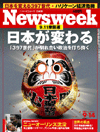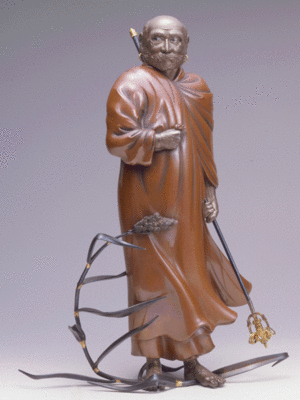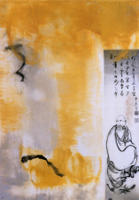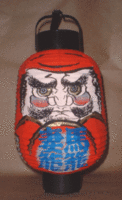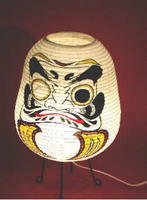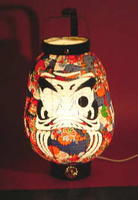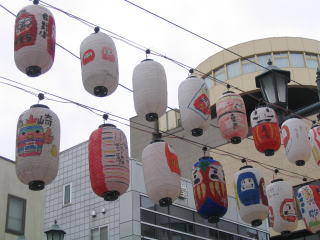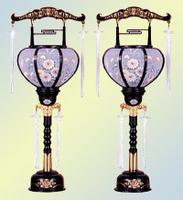:::::::::::::::::::::::::::::::::::::::::::::::::::::::::::::::::::::::::::::::::::::::::::::::::::::
Engimono, little things for good luck 縁起物

Things red, round and small are pretty good for your auspicious future, especially during the New Year season. Daruma is one of them, but there are others.
Why is the Tumbler Doll Daruma always of RED color?
Red was the color of the robe of a high-ranking priest and since Daruma Daishi was the founder of the Zen Sect, he must have worn a red robe. The patterns painted in gold on the doll represent the Buddhist stole that a priest wore.
During the Edo Period, Daruma came to be seen by the townspeople as the healer of smallpox. Nowadays we have medicine to cure this illness, but in former times children suffered a lot from this and other diseases. It was believed that RED would ward off diseases, so the Red Daruma Doll with a threatening face became the preventor and healer of sickness. Modern medicine has found out that the color red really helps prevent smallpox!
Who is Daruma ?
hoosoo-e 疱瘡絵 prints to protect children from smallpox
:::::::::::::::::::::::::::::::::::::::::::::::::::::::::::::::::::::::::::::::::::::::::::::::::::

CLICK for more books about the toys of Edo.
江戸の縁起物 - 浅草仲見世 助六物語
Engimono - The Good Luck Charms of Edo
. Tokyo and Edo Folk Art .
:::::::::::::::::::::::::::::::::::::::::::::::::::::::::::::::::::::::::::::::::::::::::::::::::::
Now let us look at some others.
Why is the monkey a symbol of good luck? In Japanese, you can say
ma ga saru, 魔が去る, the bad luck is going to leave.
SARU means also monkey, so the monkey might help to make your bad luck go away.
Migawari-zaru of Naramachi, a Monkey Charm to take on your bad luck
In the old part of Nara, ther is a special custom to hang out a small red monkey to ward off evil. A special Kooshin-do Hall (庚申堂) is dedicated to the blue-faced heavenly guardian called Kooshin-san. Good-luck charms modeled after a monkey, which acts as a messenger from Kooshin-san, are hanging at the eaves of houses in Nara-machi so that evil spirits can be driven away. The charm is called "Migawari-zaru," or a monkey of substitution, because the monkey is supposed to get disasters in place of people. One doll for each person of the home is hanged on the eves of the house.
The Kooshin Deity (庚申 Koojin, Koshin, Kojin, Koshin) is also venerated in Chinese Daoism and this believe was taken over by the townspeople during the Edo period. There was this belief:
During one year according to the old lunar calendar, there are six Kooshin-days of the monkey. Three worms which inhabit the human body (san-shi no mushi) get out on these days and report the sins of the people to the gods. Kooshin was a popular deity that protected those who should be punished by the gods, and his messenger, the monkey, was therefore punished instead of the human sinner. Hence the name “migawari” “instead of my body”.
Migawari Monkey

http://www.naramachi.org/what/migawari.html
Why would a monkey take on the punishment of human sins?
The explanation brings us to Dunhunag, the oasis in the Gobi desert with the 1000 Buddhist caves, where there is a picture of a monkey bound by hand and feet, with a band around his belly. A monkey was believed to protect humans from evil and in the charming story of the Chinese pilgrim walking all the way to India to obtain Buddhist sutras, one of his magic protectors was the famous Monkey Son-Gokuu 孫悟空。
This extremely famous story has been translated into English by Arthur Waley, MONKEY.

http://homepage1.nifty.com/tadahiko/NANI/014-KOJIN.HTML
Another name of the charm is "Negai-zaru," or a monkey for wishes. If you write your wishes on the monkey's back and hang it, your wishes are said to come true.
http://urano.org/kankou/naramati/mati10.html#kousin
「ならまち民話地図」
in many languages, PDF-files

source : nara-edu.ac.jp
. san-shi no mushi, sanshi no mushi 三尸の虫 The Three Worms .
. medicine for kan no mushi 疳の虫 .
. Kooshin shinkoo 庚申信仰 Koshin Shinko belief .
. Folk Toys from Nara .
:::::::::::::::::::::::::::::::::::::::::::::::::::::::::::::::::::::::::::::::::::::::::::::::::::::
Kooshin Hall in NishinoShinya-cho,Nara-City
The Koshin-do Hall is dedicated to a blue-faced heavenly guardian called Koshin-san. Good-luck charms modeled after a monkey, which acts as a messenger from Koshin-san, are hanging at the eaves of houses in Nara-machi so that evil spirits can be driven away. The charm is called "Migawari-zaru," or a monkey of substitution, because the monkey is supposed to get disasters in place of people.
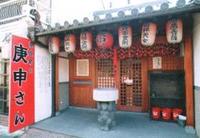
Another name of the charm is "Negai-zaru," or a monkey for wishes. If you write your wishes on the monkey's back and hang it, your wishes are said to come true.
http://www1.sphere.ne.jp/naracity/e/kan_spot_data/e_si159.html
庚申堂(こうしんどう)
「奈良オリエント館」の北隣が写真の様に古い町家続きの町並みに解け合って佇む西新町の「庚申堂」、堂内の中央に木造彩色の青面金剛立像が安置されて、毎年3月の第2日曜日と、11月23日(祝)「勤労感謝の日」に講の人達によって「庚申祭」が行われ、参拝者の方に大根とこんにゃくの田楽がふるまわれています。なお、軒下の提灯の後ろにぶら下がっている三日月形ぬいぐるみは庚申信仰の「身代わり猿」で、日頃人の体の中にいる悪玉の「三戸ノ虫」が、庚申ノ日に抜け出して、天を支配する玉皇大帝(北極星)に告げ口をしますが、悪事がばれても「身代わり猿」が人に代わって玉皇大帝の怒りを全部受けて呉れます。
http://urano.org/kankou/naramati/mati10.html#kousin
:::::::::::::::::::::::::::::::::::::::::::::::::::::::::::::::::::::::::::::::::::::::::::::::::::::
Aka-beko, akabeko, a red cow protecting from smallpox (like Daruma)
This little folk toy comes from the Tohoku region of Northern Japan.
Japanese reference
http://www.city.aizuwakamatsu.fukushima.jp/e/kanko/kokusai-kanko/area/art.htm
http://www.aizu-liaison.co.jp/liaison/sanbutu/sanbutu9.html
.......................................
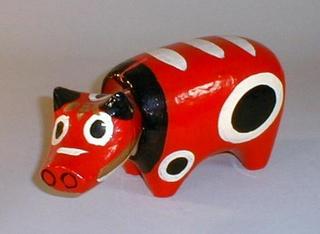
This whimsical lacquered red papier-mache figure of an ox is known as an “aka-beko” which, literally translated, means red calf. Mid-20th Century. Her head, which is attached by a string, nods up and down and from side to side. This little folk toy comes from Fukushima Prefecture in the Tohoku region of Japan. Some 350 years ago, the townspeople constructed a large temple there dedicated to Buddha.
Heavy loads of lumber had to be transported long distances, and one of the oxen used was a large reddish cow. When the building was completed, she refused to leave the site. Shortly thereafter a member of the ruling clan fashioned a small effigy of the devout cow as a child’s toy. Made of lacquered papier-mache, the free swinging head bobs easily with any movement and delights children of all ages. When a great plague of smallpox swept the country, people appealed to Buddha for deliverance.
It was noticed that children who had this toy were not afflicted with the dread disease, and the superstitious local populace began to make similar toys as amulets against illness. (See “Mingei” by Amaury Saint-Gilles) Aka-beko are looked upon as omens of good luck and prosperity and are given as gifts at New Year’s and other auspicious occasions.
Dimensions: 11” long, 5 ¼” high.
Curtesy of B & C Antiques
:::::::::::::::::::::::::::::::::::::::::::::::::::::::::::::::::::::::::::::::::::::::::::::::::::::
Continue here
Daruma Doll Museum : Cats and Daruma 猫と達磨
Read a detailed essay by Mark Schumacher about the Monkeys in Japanese art and lore. !!!
Information about
Hoosoo 疱瘡 <> Smallpox, Red and Daruma (by Bernard Faure) An Essay
Edo Toys and beni lipstick
... ... ...

http://www.naramachi.org/what/migawari.html
The Three Worms in Taoism and Chinese Mecicine
www.ancientway.com/pages/ThreeWorms.html
:::::::::::::::::::::::::::::::::::::::::::::::::::::::::::::::::::::::::::::::::::::::::::::::::::::
! More Engimono !
- click on the images for more -
DARUMA
Founder of Zen Buddhism in China. Fill in one eye and make a wish. Fill in the other eye when the wish has come true.
Tumbler Dolls (okiagari-koboshi)
That is another version of our Daruma san. For the New Year, you get just one more than members of the family and pray for health and good luck. This is a doll and custom of Aizu Wakamatsu, Northern Japan.
Golden Crucian Carp (金鮒)
This wonderous fish called FUNA from Ibaragi prefecture helps cure smallpox too. Especially when you eat it.
Kirin 麒麟 Kirin, not the giraffe
Legendary animal from China.Body like a deer, tail like an ox, hoofs like a horse, forehead like a wolf, with wings to take off to the clouds. Appears when a king was crowned in ancient China. Today a good beer!
. Kirinjishi 麒麟獅子 Kirin Lion Head .
Hare in the Moon (tsuki no usagi)

He pounds the herb of immortality to make the elixir of long life.
Pounding rice in the moon
Mallet for Good Luck (fuku-tsuchi)
Usually held by the Daikoku, one of the Seven Gods of Good Luck. You hammer your straw, make sandals of it, sell them and voila, you are a rich man.
Manekineko, maneki neko 招き猫 the beckoning cat
At the entrance of a shop or restaurant, she helps pulling customers in the store.The left hand up beckons for financial luck,The right hand up for a thousand customers- or vice versa, who knows?!
Mount Fuji (Fuji-san)

If your first dream of the New Year shows you this mountain, you are lucky for the rest of the year.
First Dream ... a kigo
New Year Ricecakes (kagami-mochi 鏡餅)
Decorated and later eaten in a good soup.This is maybe the most common New Year decoration.
Raijin 雷神 God of Thunder
A deity taken over from ancient Indian religion. Protector of the harvest.Usually with his buddy, the God of the Winds (fuujin raijin).
Gods of the Elements
Shichifuku-jin 七福神 <> Seven Gods of Good Luck
Usually shown in a “Boat of Treasures” (takara-bune)
Tanuki 狸 ... A Badger posing as Daruma
Usually made of Shigaraki Pottery. He brings luck with many parts of his own body and things he is carrying.
:::::::::::::::::::::::::::::::::::::::::::::::::::::::::::::::::::::::::::::::::::::::::::::::::::::
全国区の縁起物 だるま(No.1076)
Good Luck Daruma from all parts of Japan

Tokyo Shinbun 東京新聞
source : www.tokyo-np.co.jp
:::::::::::::::::::::::::::::::::::::::::::::::::::::::::::::::::::::::::::::::::::::::::::::::::::::
Go-en ga arimasu yoo ni!
ご縁がありますように!
May we be bound by good fortune and good karma!
a pun with go en 五円 five yen coin !

Shared by Kunio Wakabayashi
Joys of Japan
. tashoo no en 他生の縁 karma relations and haiku .
:::::::::::::::::::::::::::::::::::::::::::::::::::::::::::::::::::::::::::::::::::::::::::::::::::::
. Engi food for the New Year .
. Engi Food - the Octopus .
. Regional Folk Toys from Japan .
[ . BACK to DARUMA MUSEUM . TOP . ]
[ . BACK to WORLDKIGO . TOP . ]
- #engimono #goodluck #newyear -
:::::::::::::::::::::::::::::::::::::::::::::::::::::::::::::::::::::::::::::::::::::::::::::::::::::
